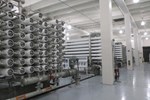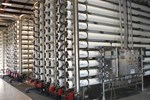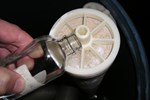HAROLD FRAVEL ARTICLES
-
Exploring RO's Inner Net3/14/2018
A deep dive into reverse osmosis (RO) elements reveals the importance of feed channel spacers for optimal membrane filtration system performance.
-
Industry Innovations For Reverse Osmosis Concentrate: A Challenging Liability Becomes A Valued Asset9/22/2016
Unlike dead-head filtration characterized by a single flow in and out, both reverse osmosis (RO) and nanofiltration (NF) technologies are unique in that they produce two effluent streams, a lower TDS (total dissolved solids) permeate and a higher TDS concentrate.
-
In The Beginning… The Origin Of Membranes As Told By The Industry's Seasoned Pioneers3/17/2016
In 2011, the American Membrane Technology Association (AMTA) embarked on an ambitious effort to preserve the history and evolution of the membranes industry. The project complimented a tradition of recognizing outstanding achievements in membrane technology and the awards extended to deserving recipients throughout the year.
-
Dynamic Improvements In Low Pressure Membranes And System Design1/20/2016
We are programmed to believe that the word “fouled” is inherently bad, identifying something that is dirty, unclean, or contaminated. But for those of us in the membrane industry, the physical presence of “foulants” simply confirms that our treatment was necessary and that our process is successfully producing a more pristine effluent.
-
Innovative Options For Brackish And Wastewater RO Concentrate Disposal6/1/2015
In an era of inspired recycling and enviable reuse of industrial and manufacturing byproducts, the water treatment industry continues to search for innovative disposal options or, better yet, viable secondary use options for high TDS (total dissolved solids) RO (reverse osmosis) concentrate streams
-
Understanding The Dynamics Of Reverse Osmosis: Fluctuations In Flow, Rejection, And Pressure3/31/2015
What you don’t know about your reverse osmosis membrane feedwater may surprise you — and hurt your system’s performance.
-
Understanding Salt Solubility Reaps Benefits In RO System Performance10/16/2014
No matter where it originates, the feed water to downstream reverse osmosis (RO) and nanofiltration (NF) membranes contains some level of dissolved salts.
-
Understanding Salt Passage Vs. Salt Rejection In Reverse Osmosis Systems8/29/2014
Knowing the dynamics of membrane separation and distinguishing salt rejection and salt passage and how they’re calculated is necessary to understand the unique operational behaviors of reverse osmosis (RO), nanofiltration (NF), microfiltration (MF), and ultrafiltration (UF) systems.
-
Decrease Membrane Treatment Capital And O&M Costs With Optimum Flux Rates6/30/2014
Despite a global effort to standardize units of measure to the metric system, the water treatment industry still follows the U.S. trend in resisting that directive by referring to water volumes in treatment plants as gallons per day (GPD). While achieving a specified permeate GPD is certainly important in overall membrane plant design, production capacity has absolutely nothing to do with determining optimal methods of treating site-specific feedwaters and offers no indication of potential membrane fouling rates and related maintenance costs. To evaluate these factors, knowledgeable professionals rely on membrane flux rates as the key consideration in achieving optimal system design and operation. By Harold G. Fravel Jr., Executive Director, American Membrane Technology Association and Karen Lindsey, VP, Avista Technologies, Inc.
-
Understanding The Critical Relationship Between Reverse Osmosis Recovery Rates And Concentration Factors4/28/2014
Every aspect of a reverse osmosis (RO) membrane operation requires some degree of process math. Changes in operating conditions that may be considered minor can actually have significant and detrimental effects on system performance. This is certainly the case when calculating system recovery rates, and the subsequent changes in concentration factors, in RO plant operation.









